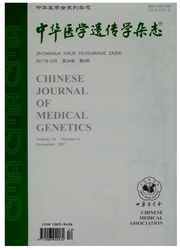

 中文摘要:
中文摘要:
目的研究Dravet综合征患儿SCN1A基因新生突变的来源,为遗传咨询及产前基因诊断提供指导。方法收集Dravet综合征患儿及其父母外周血DNA,应用Sanger测序进行SCNlA基因突变检测,应用等位基因特异性PCR方法分析新生突变的家系突变等位基因的来源;对于父源等位基因存在新生突变的家系,提取其父亲精液DNA,分析精液细胞中是否存在突变。结果22例携带SCN1A新生突变的患儿中,19例(86.4%)的突变位于父源等位基因,3例(13.6%)位于母源等位基因。9例父源等位基因突变患儿父亲的精液细胞中均未发现相应突变。结论Dravet综合征患儿SCN1A基因新生突变多位于父源等位基因,患儿父亲精液中未发现基因突变,有待进一步研究。
 英文摘要:
英文摘要:
Objective To analyze the parental origin of de novo SCN1A mutations in 2Z patients with Dravet syndrome (DS). Methods Clinical data and peripheral blood DNA of the patients and their parents were collected. SCN1A gene mutation was screened by polymerase chain reaction (PCR) and Sanger sequencing. For de novo mutations, allele-specific-PCR (AS-PCR) was used to determine their parental origins. Should the mutations be of paternal origin, semen specimen for their fathers was analyzed using PCR and Sanger sequencing for SCN1A gene mutations. Results The parental origins of 22 de novo mutations were successfully determined by AS-PCR. Nineteen (86. 40/00) of the mutations had a paternal origin and 3 (13.6%) had a maternal origin. For those with a paternal origin, semen samples from 9 fathers were analyzed, but no mutation was found. Conclusion The majority of de novo SCN1A mutations were of paternal origin. The same mutation was not found in semen samples from the fathers, for which deep sequencing may be necessary.
 同期刊论文项目
同期刊论文项目
 同项目期刊论文
同项目期刊论文
 期刊信息
期刊信息
